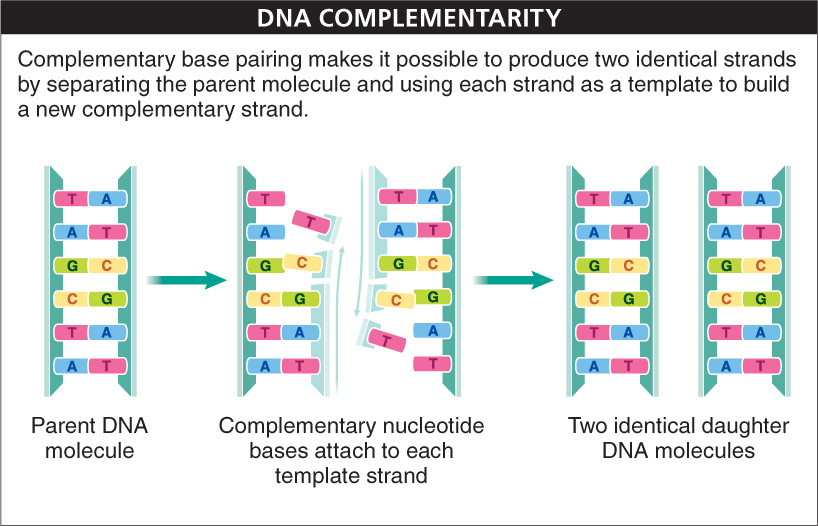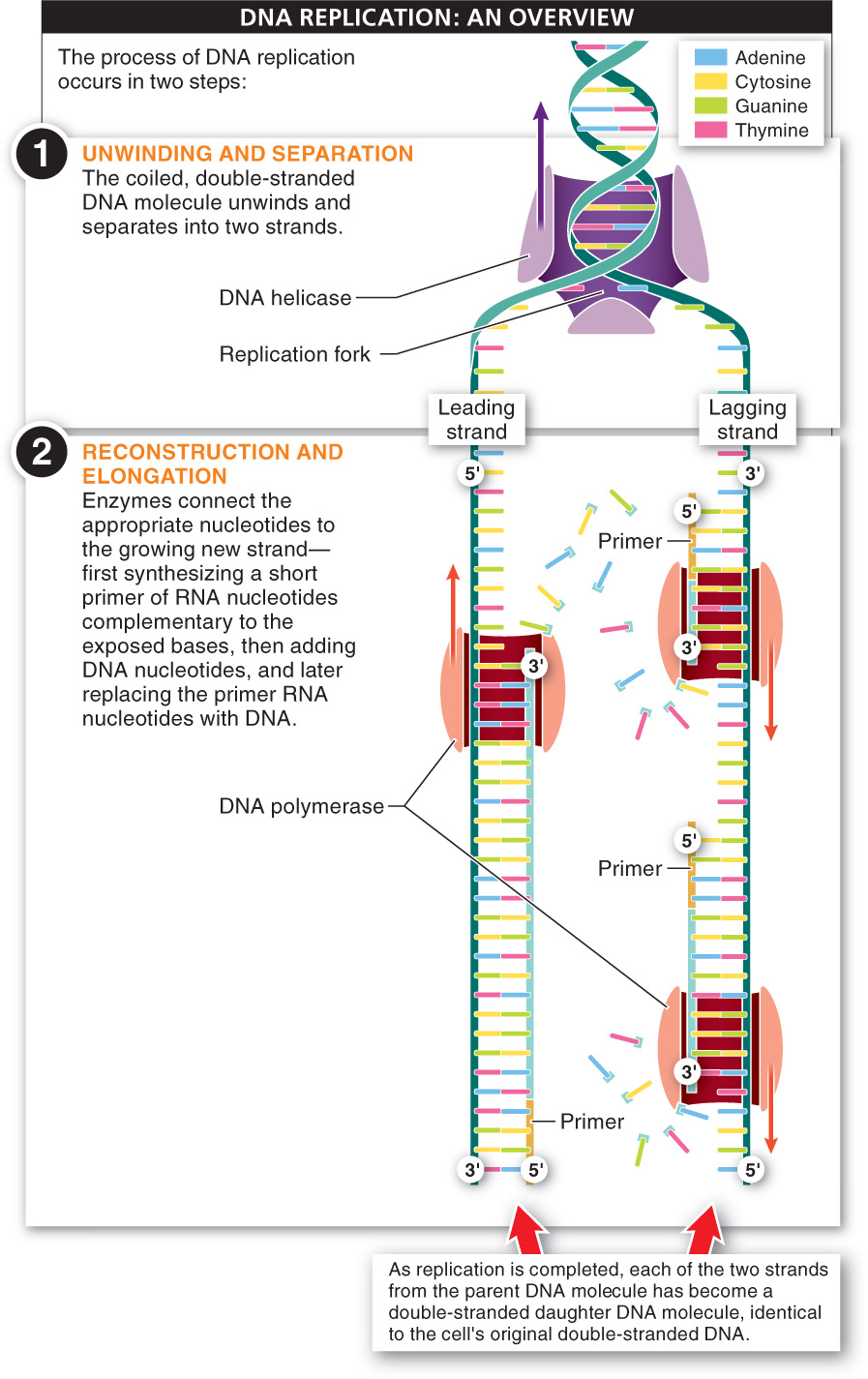6.4: Cell division is preceded by chromosome replication.
In one of the great understatements in the scientific literature, James Watson and Francis Crick wrote the following sentence in their paper describing the structure of DNA: “It has not escaped our notice that the specific pairing we have postulated immediately suggests a possible copying mechanism for the genetic material.” The researchers’ ability to explain how DNA copied itself was a critical feature of their description of DNA’s structure. After all, every single time any cell in any organism’s body divides, that cell’s DNA must first duplicate itself so that each of the two new daughter cells has all of the genetic material of the original parent cell. The process of DNA duplication, as we’ve seen, is called replication.
What is it about DNA’s structure that makes duplication so straightforward? Watson and Crick were referring to the feature of DNA called complementarity, meaning that in the double-
With this consistent pattern of pairing, when the DNA molecule separates into two strands, it is possible to perfectly reconstruct, for each strand, all the information on the missing half, because one strand carries all the information needed to construct its complementary strand. Just before cells divide, the DNA molecule unwinds and “unzips,” and each half of the unzipped molecule serves as a template on which the missing half is reconstructed. At the end of the process of reconstructing the missing halves, there are two DNA molecules—

Before we describe the process by which DNA is duplicated, it is useful to revisit the structure of DNA because it dictates the directions along the linear molecule in which replication occurs. Recall from Chapter 5 that the individual units that make up DNA are nucleotides, which have three components: a nitrogen-
9

The process of DNA replication occurs in two steps: (1) unwinding and separation of the two strands, and (2) reconstruction and elongation of new complementary strands (FIGURE 6-9). A feature of DNA that has important consequences for the process of replication is that its two strands run in opposite directions. So the backbone of the DNA molecule is a long alternation of sugar, phosphate, sugar, phosphate, sugar, phosphate, and so on, going from top to bottom in a 5′ to 3′ pattern on one side and going from bottom to top in a 5′ to 3′ pattern on the opposite side.

1. Unwinding and separation. Replication begins at a specific site, called the origin of replication, where the coiled, double-
2. Reconstruction and elongation. In the reconstruction and elongation process, each of the single strands becomes a double strand as the appropriate complementary base of a nucleotide pairs with the exposed base, and enzymes link the nucleotides of the new strand together.
10
As we described above, the two strands of the original DNA molecule run in opposite directions (5′ to 3′ on one side and 3′ to 5′ on the other). This fact, along with the fact that new nucleotides can be added only to the 3′ end of a growing strand, means the synthesis of DNA on the two template strands must occur in opposite directions.
At the replication fork, a group of several proteins, called a replication complex, binds to each of the exposed strands. This complex includes the enzymes primase and DNA polymerase. Bound to a template strand, primase synthesizes a short sequence of RNA nucleotides, called a primer, that is complementary to the template strand at that point. DNA polymerase then adds new DNA nucleotides to the 3′ end of the primer as it builds a strand complementary to the template strand.
For one of the template strands, called the leading strand, the DNA is unwound and separated and the complementary strand is built as the replication complex simply adds nucleotides in the 5′ to 3′ direction, toward the replication fork as it moves along the strand. The new double-
11
The other template strand, which is called the lagging strand, requires a more complicated, discontinuous process. At the replication fork, primase adds an RNA primer to the lagging strand. Building the complementary strand in the 5′ to 3′ direction, however, leads to the addition of nucleotides in the direction opposite to the movement of the replication fork. DNA polymerase then continues the synthesis of the complementary strand, away from the replication fork, until it encounters a previously synthesized section (see Figure 6-
While this occurs, however, the replication fork has continued to move in the opposite direction, exposing additional single-
DNA replication occurs in all types of cells, somatic and reproductive, before cell division. The end result of replication is two double-
DNA Proofreading and Error Correction A variety of mutations (such as mismatched bases and added or deleted segments) can occur during replication (or when DNA is damaged by some external source, such as X rays). Because DNA polymerases perform proofreading functions as well as excision and repair functions, many of these errors are caught and repaired during or after replication or whenever they occur.
Q
Question 6.1
Errors sometimes occur when DNA duplicates itself. Why might that be a good thing?
If an error remains, however, the sequences in a replicated DNA molecule (including the genes) can be different from those in the parent molecule. A changed sequence may then produce a different mRNA sequence, which may in turn produce a different amino acid sequence. As a result, the changed sequence may lead to the production of a different protein. The error rate in eukaryotes is very low—
TAKE-HOME MESSAGE 6.4
Every time a cell divides, that cell’s DNA must first duplicate itself so that each of the two new daughter cells has all the genetic material of the original parent cell. The process of DNA duplication, called replication, is catalyzed by several important enzymes and occurs in two steps: unwinding and separation of the two strands, and reconstruction and elongation of the new complementary strands. The end result is two double-
In a single sentence, briefly describe the two main steps in DNA replication.
12